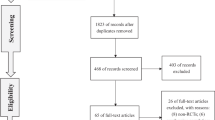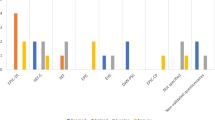Abstract
It is well known that the administration of phosphodiesterase type-5 inhibitors (PDE5-Is) may improve erectile function (EF) recovery after bilateral nerve-sparing radical prostatectomy (BNSRP). The aim of our study was to identify predictors of the use of a high number of PDE5-Is (one or more per week) after surgery among 184 patients taking proerectile medications on demand. At a mean follow-up of 22.7 months, 116 patients (63%) recovered EF. Overall, EF recovery rates at 1- and 2- year follow-up were 47.3% and 65.4%, respectively. Overall, 43 (23.4%) patients used one or more PDE5-Is per week. Preoperative EF was the only predictor of the use of one or more PDE5-Is per week after BNSRP. This held true even after adjusting our analyses for age at surgery, body mass index and EF at 1 month after surgery. Particularly, patients fully potent before surgery had roughly 2.1-fold higher probability of using one or more pills per week compared with their counterparts with some degree of preoperative erectile dysfunction (ED; odds ratio: 2.16; 95% confidence interval: 1.03–4.37). In conclusion, preoperative EF represents the only determinant of the use of a higher number of PDE5-Is after surgery. Patients with better preoperative EF might represent individuals more motivated to achieve satisfactory sexual function after surgery. These observations should provide physicians with better preoperative patient counseling and management of postoperative ED.
This is a preview of subscription content, access via your institution
Access options
Subscribe to this journal
Receive 8 print issues and online access
$259.00 per year
only $32.38 per issue
Buy this article
- Purchase on Springer Link
- Instant access to full article PDF
Prices may be subject to local taxes which are calculated during checkout

Similar content being viewed by others
References
Abdollah F, Sun M, Thuret R, Jeldres C, Tian Z, Briganti A et al. A competing-risks analysis of survival after alternative treatment modalities for prostate cancer patients: 1988-2006. Eur Urol 2011; 59: 88–95.
Cooperberg MR, Vickers AJ, Broering JM, Carroll PR . Comparative risk-adjusted mortality outcomes after primary surgery, radiotherapy, or androgen-deprivation therapy for localized prostate cancer. Cancer 2010; 116: 5226–5234.
Ficarra V, Sooriakumaran P, Novara G, Schatloff O, Briganti A, Van der Poel H et al. Systematic review of methods for reporting combined outcomes after radical prostatectomy and proposal of a novel system: the survival, continence, and potency (SCP) classification. Eur Urol 2012; 61: 541–548.
Sanda MG, Dunn RL, Michalski J, Sandler HM, Northouse L, Hembroff L et al. Quality of life and satisfaction with outcome among prostate-cancer survivors. N Engl J Med 2008; 358: 1250–1261.
Stanford JL, Feng Z, Hamilton AS, Gilliland FD, Stephenson RA, Eley JW et al. Urinary and sexual function after radical prostatectomy for clinically localized prostate cancer: the Prostate Cancer Outcomes Study. JAMA 2000; 283: 354–360.
Boorjian SA, Eastham JA, Graefen M, Guillonneau B, Karnes RJ, Moul JW et al. A critical analysis of the long-term impact of radical prostatectomy on cancer control and function outcomes. Eur Urol 2012; 61: 664–675.
Kim SC, Song C, Kim W, Kang T, Park J, Jeong IG et al. Factors determining functional outcomes after radical prostatectomy: robot-assisted versus retropubic. Eur Urol 2011; 60: 413–419.
Dubbelman YD, Dohle GR, Schroder FH . Sexual function before and after radical retropubic prostatectomy: a systematic review of prognostic indicators for a successful outcome. Eur Urol 2006; 50: 711–718, discussion 718-720.
Briganti A, Capitanio U, Chun FK, Karakiewicz PI, Salonia A, Bianchi M et al. Prediction of sexual function after radical prostatectomy. Cancer 2009; 115 (13 Suppl): 3150–3159.
Rabbani F, Stapleton AM, Kattan MW, Wheeler TM, Scardino PT . Factors predicting recovery of erections after radical prostatectomy. J Urol 2000; 164: 1929–1934.
Bannowsky A, Schulze H, van der Horst C, Hautmann S, Junemann KP . Recovery of erectile function after nerve-sparing radical prostatectomy: improvement with nightly low-dose sildenafil. BJU Int 2008; 101: 1279–1283.
Montorsi F, Brock G, Lee J, Shapiro J, Van Poppel H, Graefen M et al. Effect of nightly versus on-demand vardenafil on recovery of erectile function in men following bilateral nerve-sparing radical prostatectomy. Eur Urol 2008; 54: 924–931.
Gandaglia G, Albersen M, Suardi N, Gallina A, Abdollah F, Castiglione F et al. Postoperative phosphodiesterase type 5 inhibitor administration increases the rate of urinary continence recovery after bilateral nerve-sparing radical prostatectomy. Int J Urol 2013; 20: 413–419.
Gandaglia G, Suardi N, Gallina A, Capitanio U, Abdollah F, Salonia A et al. Preoperative erectile function represents a significant predictor of postoperative urinary continence recovery in patients treated with bilateral nerve sparing radical prostatectomy. J Urol 2012; 187: 569–574.
Walsh PC, Donker PJ . Impotence following radical prostatectomy: insight into etiology and prevention. J Urol 1982; 128: 492–497.
Suardi N, Moschini M, Gallina A, Gandaglia G, Abdollah F, Capitanio U et al. Nerve-sparing approach during radical prostatectomy is strongly associated with the rate of postoperative urinary continence recovery. BJU Int 2013; 111: 717–722.
Padma-Nathan H, McCullough AR, Levine LA, Lipshultz LI, Siegel R, Montorsi F et al. Randomized, double-blind, placebo-controlled study of postoperative nightly sildenafil citrate for the prevention of erectile dysfunction after bilateral nerve-sparing radical prostatectomy. Int J Impot Res 2008; 20: 479–486.
Cappelleri JC, Rosen RC, Smith MD, Mishra A, Osterloh IH . Diagnostic evaluation of the erectile function domain of the International Index of Erectile Function. Urology 1999; 54: 346–351.
Briganti A, Gallina A, Suardi N, Capitanio U, Tutolo M, Bianchi M et al. What is the definition of a satisfactory erectile function after bilateral nerve sparing radical prostatectomy? J Sex Med 2011; 8: 1210–1217.
Gandaglia G, Suardi N, Gallina A, Abdollah F, Capitanio U, Salonia A et al. Extended pelvic lymph node dissection does not affect erectile function recovery in patients treated with bilateral nerve-sparing radical prostatectomy. J Sex Med 2012; 9: 2187–2194.
Montorsi F, Briganti A, Salonia A, Rigatti P, Burnett AL . Current and future strategies for preventing and managing erectile dysfunction following radical prostatectomy. Eur Urol 2004; 45: 123–133.
Edwards B, Clarke V . The psychological impact of a cancer diagnosis on families: the influence of family functioning and patients' illness characteristics on depression and anxiety. Psychooncology 2004; 13: 562–576.
Author information
Authors and Affiliations
Corresponding author
Ethics declarations
Competing interests
The authors declare no conflict of interest.
Rights and permissions
About this article
Cite this article
Gandaglia, G., Gallina, A., Suardi, N. et al. Preoperative erectile function is the only predictor of the use of a high number of phosphodiesterase type-5 inhibitors after bilateral nerve-sparing radical prostatectomy. Int J Impot Res 26, 201–204 (2014). https://doi.org/10.1038/ijir.2014.10
Received:
Revised:
Accepted:
Published:
Issue Date:
DOI: https://doi.org/10.1038/ijir.2014.10
This article is cited by
-
Non-surgically related causes of erectile dysfunction after bilateral nerve-sparing radical prostatectomy
Prostate Cancer and Prostatic Diseases (2016)
-
Erection rehabilitation following prostatectomy — current strategies and future directions
Nature Reviews Urology (2016)



